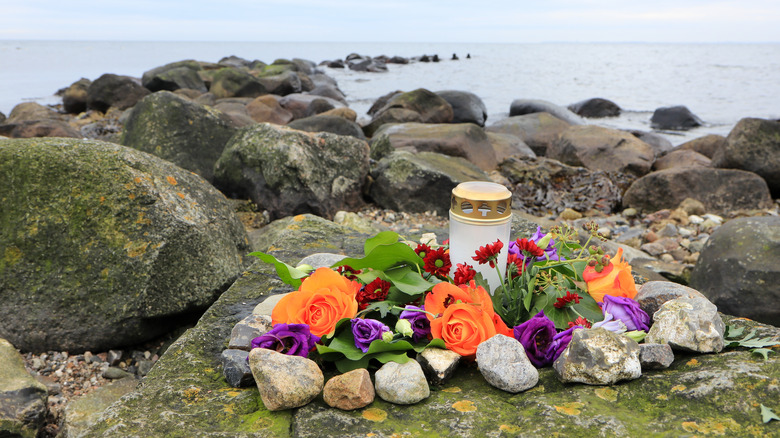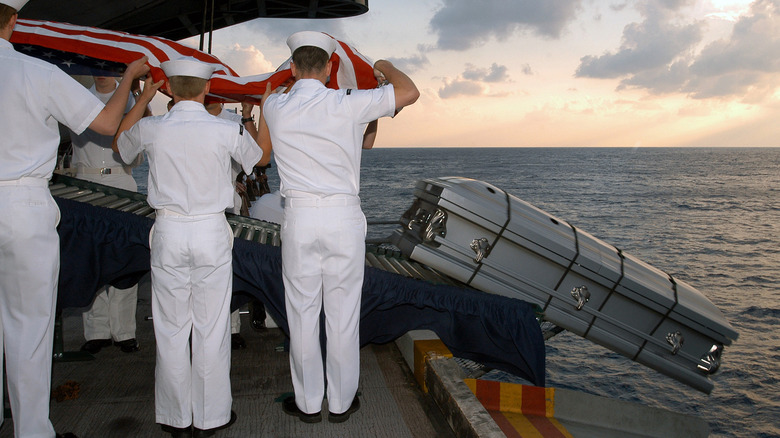What Happens To A Body That Is Buried At Sea?
From burning mortal remains to burying dead bodies under the ground, different cultures around the world follow different rituals to honor their loved ones and aid departed souls to reach salvation (via Britannica). In Tibet, for instance, many Buddhists follow the practice of sky burial. In this ritual, the grieving family places the corpse in the open, cuts it into slivers, and feeds the carcass to vultures allowing the birds to take the deceased's soul to heaven. Per ABC News, sky burial ensures nothing is left of the dead, even pulverizing the bones before combining the fragments with butter and flour so the birds will consume that part, too.
In India, some Hindus immerse the ashes in the Ganges River a day or two after the cremation to let their loved ones escape the cycle of rebirth, as National Geographic describes. Americans have traditionally buried their loved ones in caskets six feet underground, though according to the Cremation Association of North America, in 2021 more than 57% of the dead were cremated, nearly double the amount from 2006. When buried in coffins, the corpse is usually reduced to bone fragments (via Business Insider). But what happens to a body that is buried at sea?
The Seabed – Where The Dead Are Laid To Rest
According to researcher David J. Stewart (via ResearchGate), during the Age of Sail, the period from the mid-16th to the mid-19th century, some English and American sailors routinely performed sea burial to prevent the departed soul from becoming an unsettled spirit who may return to haunt the ship. Also, since trade and warfare were largely dominated by sailing ships, it was difficult for the sailors to bring the deceased's decaying body back to the shore and perform the last rites on land.
In modern times, though, it seems to have become a choice. Per the Los Angeles Times, the decision to bury the dead in the sea depends on a variety of reasons, including financial (it's more cost-effective than a ground burial), environmental (cremation releases CO2), and spiritual (transcends religious beliefs).
"I hear things like, 'I like the idea of becoming a drop of rain one day, and if I'm in the ocean, I can become rain on the mountaintop," says Olivia Bareham, founder of the Sacred Crossings Institute and Funeral Home in Los Angeles. "If we think we are a drop in the ocean of bliss, it makes sense to return to the ocean."
The Body Breaks Down Faster In Deep Water
The rate at which a corpse can decompose depends on the temperature of the water, time of the year, the depth of the sea, and local faunal composition, according to Mother Jones. Per Science Focus, a body can take five years to skeletonize in very cold water, even as aquatic animals may only take a week to finish off the flesh. But as described, there are many variables.
"Earlier studies in Saanich Inlet [about 328 feet deep] and Howe Sound [about 23 to 49 feet deep] indicate that a (pig) carcass approximating a human body in torso size, skin type, and internal bacteria would be likely to survive for weeks or months, depending on oxygen levels, season, depth and whether it remained in contact with the seabed," notes Gail Anderson, Simon Fraser University criminologist (via ScienceDaily).
To ensure the dead body remains in the ocean, the United States Environmental Protection Agency mandates that sea burials must take place at least three nautical miles from shore and in at least 600 feet of water (via the Los Angeles Times). In addition, the mortal remains must be either in coffins wrapped in stainless-steel chains or covered in a weighted, biodegradable shroud. In the United Kingdom, per BBC, sea burials can only be conducted at three designated burial sites in English coastal waters.


